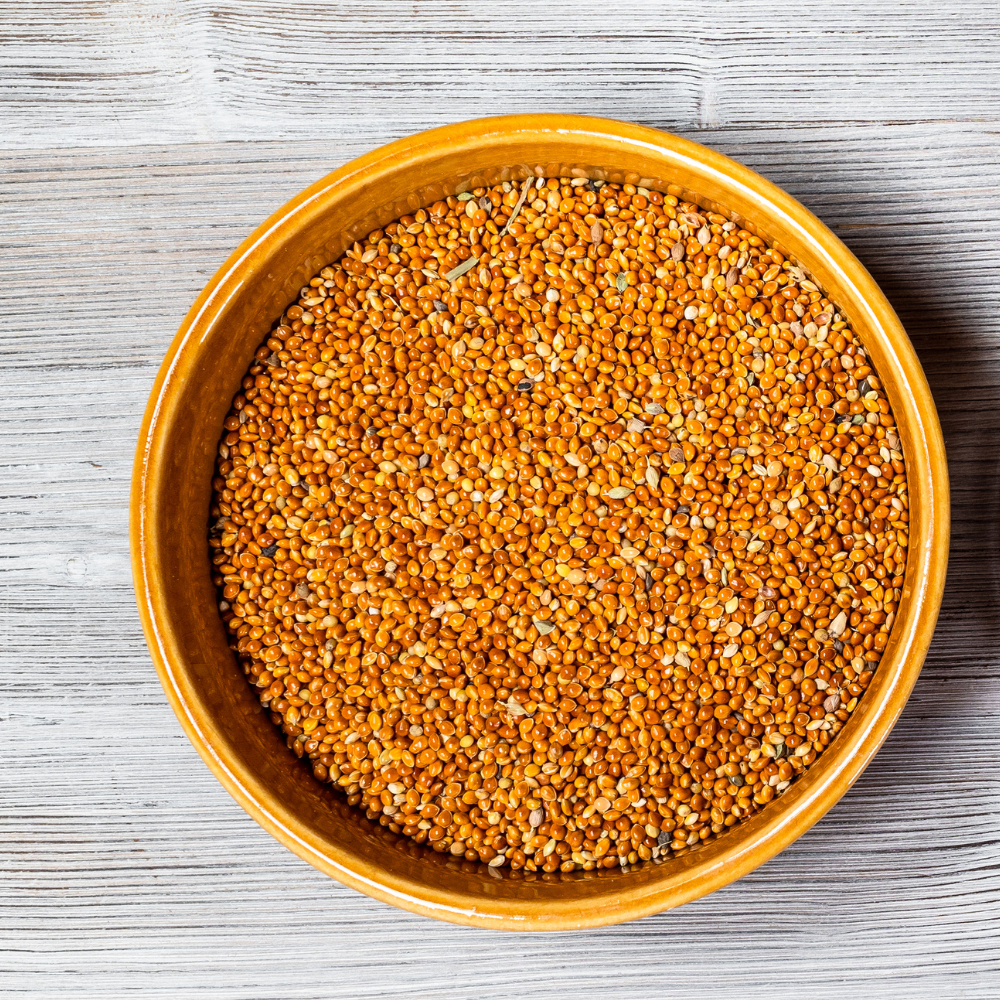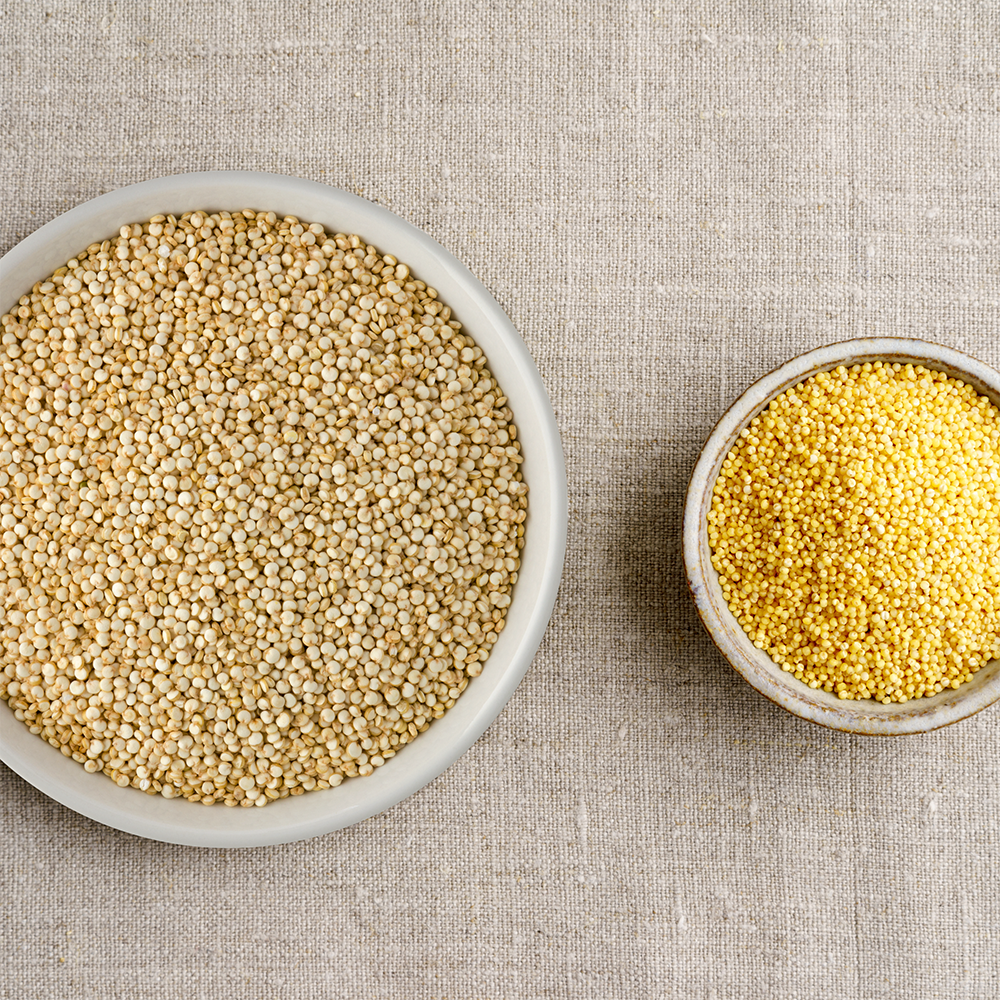These days, Oats and Millet are the two most talked-about cereals for their health benefits among fitness enthusiasts. However, oats have left millets behind with numerous oat-based products: rolled oats, savoury oats, instant oats, oat energy bars, and so on.
Millets, once thought to be ancient grains, are also slowly making their way into our life as millet cereals, flours, granolas, malt, energy bars, etc. Both oats and millet are nutritious, healthy, and flavourful.
So, if there is a face-off between Oats and Millets, which one would you pick as the winner?
Simply look at the different aspects of nutrition, health benefits, diet requirements, etc. That sounds like a lot of research, right?
No worries! This blog- “Oats vs Millets ”, will help you pick the best grain for your and your family's health.
Let’s start with an overview of oats and millet; later, we will look at their nutritional and health benefits comparison.

|
Table of Contents
|
Oats vs Millets: An Introduction
Millets and oats are considered nutri-cereals and have been a source of nutrition for ages, for both humans and animals.
In India, oats are also called Jae or Jau in Hindi-speaking states. They are primarily grown in the northern states of India, largely in Haryana, Rajasthan, Gujarat, and some parts of Uttar Pradesh and Madhya Pradesh. Oats are widely available in four varieties in the market. They are
The oat kernel is broken into two or three large particles using a steel blade.
The oat kernels are steamed and then rolled or pressed into flakes.
Oat Bran is made of oat husk, or outer covering and does not contain kernels; it’s basically a store of fibre.
The whole oat grains are crushed and they contain the whole kernel (germ, endosperm and bran).
Out of the four types, rolled oats are the most readily available and are highly processed.
Alright! Let’s learn about millets now.
Millets are small-sized seed grass grains. They are hardy and can grow in drought or hot and dry climatic conditions. Millets are of various kinds. But, broadly, they are categorized into two categories: Major and Minor millets.
|
Major Millets |
Minor Millets |
|
|
Millets offer a wide variety to choose from and are often used to treat specific health conditions. Millets are considered an environmentally friendly grain. They can be harvested 3 to 4 times a year, require less water for irrigation, are resistant to insects and pests, and can be easily grown organically.
Looking at the current environmental conditions, millets have attracted nations around the world . They are considered as the most sustainable crop, good for humans and the Earth.
This ends the first face-off round between Oats vs Millets. It looks like Millet has the lead. Now, the next round between Oats vs Millets is to compare their nutritional aspects. Aren’t you curious to find out who wins this one?
Oats vs Millets: Nutritional Aspects
Take a clear look at the chart below; you can see the numerous nutrients present in oats and millet. The highest values of the nutrients are highlighted. Both oats and millets offer a good amount of protein, fats, calcium, fibre, and antioxidants, making them a good addition to anyone’s diet.
However, millet can be used to fulfil the targeted requirements of the body. Like finger millet for calcium and iron, vitamin A, and vitamin B3. Whereas Proso millet is for vitamin B3 and protein, Adlay millet is for protein, iron, and so on.
Millets are also rich in essential amino acids lie isoleucine, leucine, lysine, methionine, phenylalanine, histidine, threonine, tryptophan, and valine.
|
Nutritional Chart for Millets and Oats (% dry-weight basis) |
|||||||||||
|---|---|---|---|---|---|---|---|---|---|---|---|
|
Millet |
Carbohydrates |
Fibre |
Protein |
Fats |
Ash |
Vitamins (mg/100g) |
Minerals (mg/100g |
||||
|
A |
B1 |
B2 |
B3 |
Ca |
Fe |
||||||
|
Finger millet |
82.3 |
3.4 |
8.7 |
1.8 |
2.8 |
6 |
0.3 |
0.1 |
1.4 |
350 |
5-9.9 |
|
Proso millet (dehulled) |
80.1 |
0.7 |
12.5 |
4.9 |
0.8 |
- |
0.41 |
0.28 |
4.54 |
8 |
2.9 |
|
Pearl millet |
75.6 |
2.3 |
11.6 |
4.8 |
2.2 |
22 |
0.3 |
0.15 |
2 |
25 |
3-9.8 |
|
Foxtail millet |
66.9 |
4.1 |
11.8 |
4.1 |
3.3 |
- |
0.6 |
0.1 |
0.99 |
20 |
4.9 |
|
Adlay millet |
85.9 |
15.1 |
6.7 |
2.5 |
- |
- |
- |
- |
- |
- |
- |
|
Polish millet |
73.6 |
8.5 |
8.7 |
3.5 |
3.8 |
0 |
0.24 |
0.14 |
2 |
44 |
8.5 |
|
Indian Barnyard millet |
74 |
2 |
15 |
5.2 |
1.3 |
- |
0.3 |
0.09 |
- |
210 |
7.6 |
|
Japanese Barnyard millet |
55.7 |
13.9 |
11.3 |
4.0 |
4.6 |
- |
- |
- |
- |
22 |
18.6 |
|
Little millet |
66.3 |
7 |
10.7 |
6.0 |
5.9 |
- |
0.41 |
0.28 |
- |
17 |
- |
|
Kodo millet |
73.5 |
8.4 |
10.2 |
3.9 |
3.6 |
- |
0.2 |
0.10 |
- |
35 |
1.7 |
|
OATS |
66.27 |
10.6 |
16.89 |
6.9 |
- |
0 |
0.76 |
0.14 |
0.96 |
54 |
4.72 |
Source: A study published by the Department of Bioresource Engineering, Faculty of Agricultural and Environmental Sciences- Nutritional Comparison of Millets with Other Superfoods.
So, in this face-off of Oats vs Millets, who are you rooting for?
Oats vs Millets: Health Benefits
Oats and Millets both have similar health benefits. However, millet is a rich source of antioxidants, essential amino acids, and polyphenols and has an edge over oats. Let’s see their benefits to learn more.
Let’s closely look at the health benefits of organic unpolished whole oats first.
- Whole oats are a rich source of the antioxidant avenanthramides, which may help lower blood pressure levels and have an anti-inflammatory and anti-itching effect.
- Whole oats have beta-glucan fibre, which may reduce cholesterol, blood sugar levels, and appetite by keeping the stomach full for a longer duration.
- Oats support the growth of microflora in the gut with the help of fibre.
- Oats are good for skin health and are widely used in DIY (do-it-yourself) skincare remedies and cosmetic formulations.
- Oat bran helps with constipation, irregular bowel movements, etc.
Alright, now let’s see the various health benefits of organic unpolished millet grains.

- Millets are anti-acidic and gluten-free.
- Millets detoxify the body by purifying the blood and the gut with the help of fibre and antioxidants present in them.
- Millets have Niacin (vitamin B3), which lowers cholesterol, keeps the skin healthy, and prevents breast cancer. The high fibre and low glycemic index of millets also help prevent type 2 diabetes.
- They are also effective in reducing blood pressure, protecting against heart diseases, and helping treat respiratory conditions like asthma.
- Millets improve kidney, liver, and immune system health.
- As millets are anti-acidic, they decrease the chances of gastrointestinal conditions such as gastric ulcers, colon cancer, etc.
- Millet's high fibre content also relieves constipation, excess gas, bloating, and cramping.
- Last but not least, millet maintains the microflora in the gut as it is prebiotic in nature.
Both millets and oats have tons of benefits. But these benefits come from consuming unprocessed organic oats and millet.
So, until now in the face-off between Oats vs Millets, can you decide who is the better contender?
Hold that thought for a few more minutes! Look at what different studies are saying about the readily available oat-based products consumed by the mass population before you come to a final decision.
Oats vs Millets: Products Under the Radar in the Market
The internet is filled with various kinds of studies done on oats and millet. Many are claiming about the health benefits, nutrients and other applications of this superfood. But here’s the catch! Most of the studies are conducted on “unprocessed forms of oats and millet”.
But what kind of oats do you buy from the market? Probably instant oats, breakfast oat cereals, granola jars, rolled oats, oatmeal, etc., right?
Now, the issue with these products is that their nutritional content and benefits are not the same as those of the unprocessed form of oats or millet.
Here are a few facts about packaged oats that you should know:
- Instant oats or oatmeal contain gluten protein, Avenin. Avenin is responsible for creating a slow inflammatory response in the body, which makes it hard to detect. It can worsen Celiac disease over time.
- Processed oats are often treated with glyphosate, which, as per the WHO, is a carcinogen (can cause cancer). Glyphosate is a chemical used to quickly dry out oat plants to reduce the oat's product processing time.
- There is not enough evidence that processed oats decrease blood glucose levels. Most of the studies use unprocessed oats, and the comparison is done against white bread.
- A laboratory test conducted by EWG found that the widely consumed oat products contain chlormequat, which is a chemical responsible for cancer and affects the growth of the child in the womb.
The point is: to get all the nutrition and benefits from oats and millet, make sure they are steel-cut, organically grown, minimally processed, unpolished, and as close to their natural form as possible.
Here’s how you can pick the best amongst Oats vs Millet Products from the market:
- Check for an organic label on the packaging.
- Buy steel-cut oats, unprocessed oats or whole oat groats.
- Prefer whole millet flours over other forms of millet.
- Look for processing information.
- Stay away from anything that says “instant”.
- Look for the date of manufacturing and buy fresh products.
- Look for the shelf life information. A longer shelf life may mean more preservatives.
FAQs - Oats vs Millets - Which One Is Healthier?
What's the difference between millet and oats?
Millet is a gluten-free grain with a slightly nutty flavor, while oats are a gluten-containing grain known for their heart-healthy properties.
Millet vs oats for weight loss: Which is a better choice?
Millet and oats are both beneficial to weight loss. Millet is gluten-free and aids digestion, but oats have specific fibres that are beneficial to the heart. Oats are also higher in protein. You can eat either way, but keep an eye on how much you consume and make sure your overall diet is balanced.
Is oats a millet?
Oats are not millet. While millet is a group of small-seeded grains from several grass species, oats are a specific type of grain.
Oats vs Millets: Conclusion
We hope that this casual face-off between Oats vs Cereals will help you make the right eating choices. It’s always better to include a variety of grains in your diet. Just like the saying goes, the more, the merrier!
Just remember to control the portion size of these highly nutritive grains; for them, a little goes a long way! And one more thing, make sure to consume quality products of oats and millet.
Wondering where to buy organic, unpolished, high-quality products? Check out Two Brothers Organic Farms for all your everyday staples Sprouted Ragi Malt - Nachni Satva, Foxtail Millets, Proso Millet, and more.
Read More :
Millet vs. Quinoa: Know These 7 Differences Before You Choose - A Quick Guide
Which Millet Is Good for Weight Loss? - Top 5 Millets You Should Include in Your Weight Loss Diet










